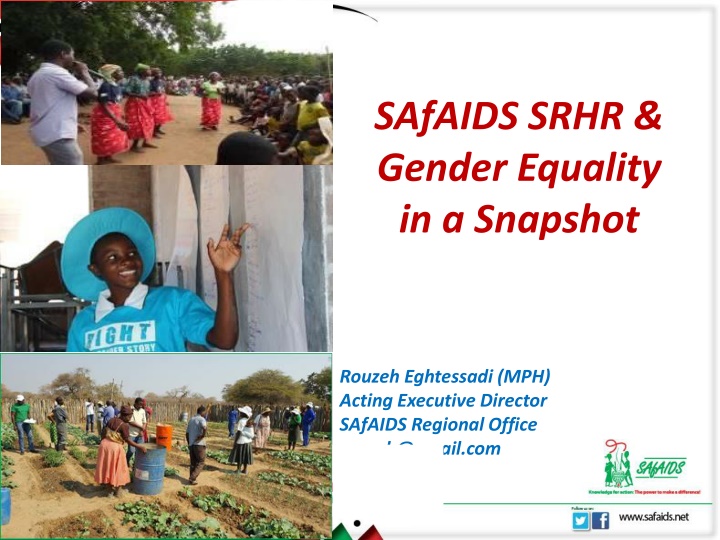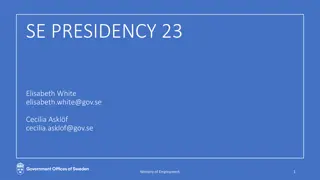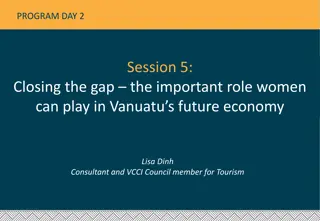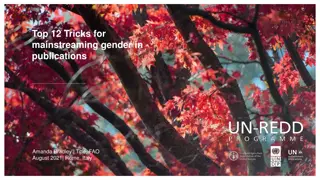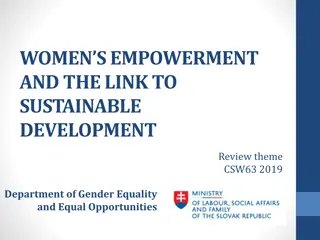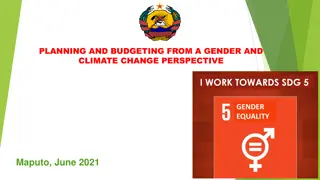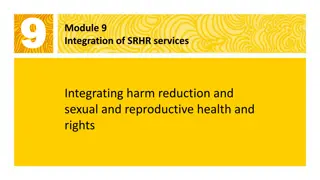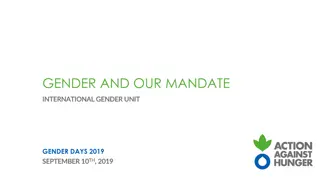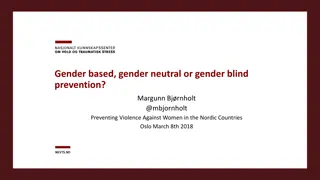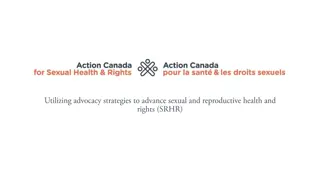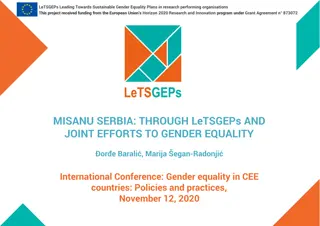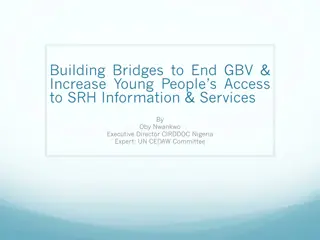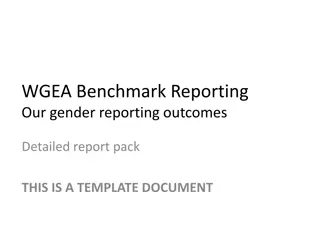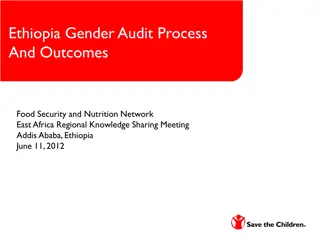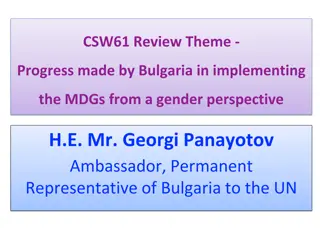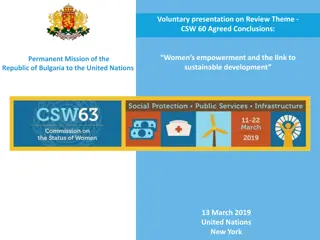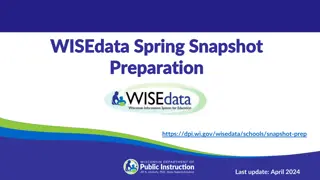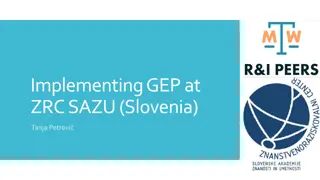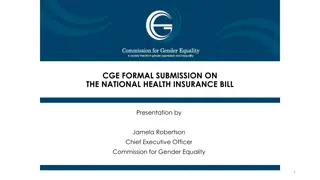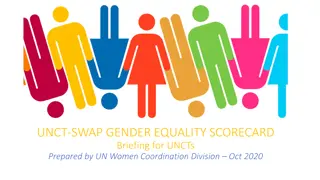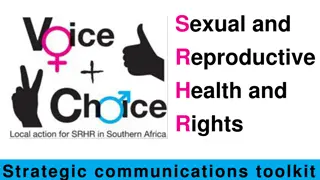SAfAIDS SRHR & Gender Equality in a Snapshot
This content delves into SAfAIDS' vision, mission, strategic objectives, regional approach, key strategies, and interventions promoting sexual and reproductive health and rights, gender equality, and community resilience in Africa.
Download Presentation

Please find below an Image/Link to download the presentation.
The content on the website is provided AS IS for your information and personal use only. It may not be sold, licensed, or shared on other websites without obtaining consent from the author.If you encounter any issues during the download, it is possible that the publisher has removed the file from their server.
You are allowed to download the files provided on this website for personal or commercial use, subject to the condition that they are used lawfully. All files are the property of their respective owners.
The content on the website is provided AS IS for your information and personal use only. It may not be sold, licensed, or shared on other websites without obtaining consent from the author.
E N D
Presentation Transcript
SAfAIDS SRHR & Gender Equality in a Snapshot Rouzeh Eghtessadi (MPH) Acting Executive Director SAfAIDS Regional Office rouzeh@gmail.com
What is Our Vision, Mission and Goal What is Our Vision, Mission and Goal Vision All People in Africa realize their Sexual and Reproductive Health and Rights (SRHR) and are Free from the Burden of HIV, GBV and TB and other health related developmental issues. Mission To be a centre of excellence that promotes effective and ethical development responses to SRH, HIV and TB prevention, treatment and care through advocacy, communication and social mobilisation Goal To complement National Governments and Regional Bodies in their efforts to reduce HIV, increase update of SRH, HIV and TB information and services, and build community resilience within southern Africa by 2020
What are Our Strategic Objectives (2016 What are Our Strategic Objectives (2016 2020) 2020) SO 3: Promote gender equality and women s rights to reduce gender based violence, access to livelihoods programmes and improve the SRH outcomes of women, children and key populations SO4: Strengthen linkages between SRH, HIV and access to livelihoods, WASH and social protection programmes to build community resilience SO5: SO 1: Scale-up access to strategic age appropriate integrated SRH, HIV, TB and NCDs information by All (young people, women, men, LGBTI, sex workers, prisoners) in hard- to-reach settings and cities SO 2: Promote access to SRH, HIV and GBV prevention services by All (young people, women, men, LGBTI, sex workers and other people left behind/key populations) in hard-to-reach areas and cities Strengthen SAfAIDS institutional capacity to be able to deliver sustained high quality programmes by 2020
Regional Approach Key Strategies: Advocacy; Social Mobilisation; Knowledge management; Capacity strengthening & mentoring; Documentation & Learning Regional Policy Advocacy, Trend Analysis, Harmonisation, Linking & Learning Global Agenda e.g. SDGs, #SheDecides National Advocacy, Learning Labs, Movement Building, Capacity Strengthening, Evidence Generation Community Behaviour change, Dialogue, Transformation
Our Interventions Our Interventions Within a Human Rights-based Approach (HRBA) facilitating enjoyment of SRHR by ALL!
1. Adolescents and Young People (10 1. Adolescents and Young People (10- -24 years) 24 years) Why: Strengthen their knowledge and skills in SRHR, HIV and GBV prevention, Facilitate gender norms transformation, Build advocacy and leadership skills to champion SRHR; Reduce risk and vulnerability How: SAfAIDS Young People Leadership Academy, and combination methodologies in next slide. Through: TLives, Her Choice, ASRHR, Untying the Gender Knot, SaSe!, PCOSE and FTT4000 Who and Where: In-school and out-of-school; rural and peri-urban and urban; in hard-to-reach and farming and mining areas What Changed: Increased knowledge, skills and competencies in SRHR, HIV and gender issues; Increased access to SRH, HTS, FP, ART, PMTCT and GBV services; Reported increase in safer sex practices; Increased reporting of GBV cases; Reported reduction in number of multiple partners; Increased advocacy for peer A&YSRH rights; amongst others
SAfAIDS Model for Adolescents and Young Peoples SRH Rights YPISA Champions (in and out-of-school) Advocacy Campaigns Holiday Camps Champion Teachers and Local Leadership Radio Listening & Reading Clubs Youth for Gender Transformation (Y4GT) AGYW Risk Reduction 3600Clubs (in and outofschool) Youth Accountability Boards (YABs) Community Referral Networks (CRNs) Sports Health Desk Multi-media Campaigns Mass & Social Media 72hr GBV Desk Capacity Strengthening & Mentoring Increased Access to Strategic HIV and SRH Information in Conducive Environments Demand Creation Dialogues (Community, Intergenerational, Hop-on Mobile taxi ) Music Bashes & Galas Engaging Families Male Involvement & Increased Demand for SRH Services by Young People (10-24yrs) Material Development & Dissemination Family Fun Days (Capacity, Advocacy, IEC) Sports Events
2. Key Populations and Missing People 2. Key Populations and Missing People Why: Increase knowledge and skills in SRHR, HIV and GBV prevention, Strengthen SRHR advocacy voice for KPs and missing people, Break barriers KPs face in SRH information and services access, Increase leadership advocacy for KP SRHR How: Indabas, Dialogues, Capacity Strengthening, SWAG (Sex Worker Action Groups), Media sensitization, Champion Leaders equipped to Speak-Out Who and Where: In rural and peri-urban and urban areas, farming and mining informal sectors, selected hotspots. Through : PITCH and KP-REACH What Changed: Increased number of Champion Leaders Speaking-Out for the rights of KPs to HIV prevention services; Sex workers empowered to advocate their rights and confidently engaging brothel owners, pastors, the police, parliamentarians, for improved access and quality of services for SWs; Reduced stigma and discrimination against SWs and LGBTI in programme sites; Increased access and uptake of HTS services; Increased correct media reportage on LGBTI SRHR violations and rights to HIV prevention services
3. Women and Men 3. Women and Men (> 25 years) Why: Increase knowledge and skills in SRHR, HIV and GBV prevention, gender norms transformation, Generate advocates for SRHR, Motivate men and boys to access SRHR service and support (female) partners to access services; Break gender inequality practices hindering women and girls enjoying their SRHR How: Gender Norms Transformation trainings, Fatherhood Clubs, MasP and WasP Clubs, Community Referral Networks, Men s Wellness Days, Home Visits, Demand Creation Community Dialogues (DCCDs) I Know Campaign and other methodologies. Through: RAA, Her Choice, Tlives, Homestead Initiative, SaSe! And MenEngage activities Who and Where: In rural and peri-urban and urban areas, from farming and mining informal sectors, in workplaces, at sports and cultural events, during traditional court sessions What Changed: Transformed gender norms; Reduced harmful cultural and religious practices; Reduced risk to HIV and GBV among women; Increased dialogue on controversial SRHR issues; Increased male engagement in PMTCT, couples HTS, and child-care; Improved health-seeking behavior among men and adolescent boys (> 25 years)
SAfAIDS Gender Norms Transformation (GNT) Model Community GNT Clubs, and Baseline to determine entry points for support to CSOs capacity strengthening and Government to roll-out relevant strategies and frameworks Community Gender Facilitator Trainings , and In schools with Young People, generating Champions Y4GT, establish Y4GT Clubs In-school Teacher s trainings Establish Fatherhood Clubs and Gender Norms Transformation Leadership Development Camps for Y4GT and other young people Gender Norms Transformation Clubs Increased men and boys advocating gender equality Community Gender Norms Transformative Dialogues Reduced risk to HIV and GBV and poor SRH outcomes
4. Leadership : Traditional, Political, Religious, 4. Leadership : Traditional, Political, Religious, Justice and Health Justice and Health Why: Strengthen their knowledge and skills in SRHR, HIV and GBV prevention; Build advocacy skills to champion SRHR and gender equality; Counter harmful cultural and religious norms and practices hindering women and girls enjoying their SRHR How: Capacity strengthening, Indabas, Culture Dialogues, Speak-Out sessions, Village to Village (V2V) Campaign. Through: TLives, Rock 90, RAA Who and Where: In rural and peri-urban and urban; in hard-to-reach and farming and mining areas What Changed: Reduced harmful cultural and religious practices; Reduced risk to HIV and GBV among women; Increased dialogue on controversial SRHR issues; Increase in leadership advocating SRHR of women
5. SRHR integrated with HIV, TB, NCDs, 5. SRHR integrated with HIV, TB, NCDs, WASH & Resilience Building in Livelihoods WASH & Resilience Building in Livelihoods Why: Strengthen household resilience and economic security to reduce risk and vulnerability to both HIV and GBV, and unsafe transactional sex for survival among women and adolescent girls; their knowledge and skills in SRHR, HIV and GBV prevention; Build advocacy skills to champion SRHR integration with other health and non-health areas How: Community social mobilisation, Livelihoods skills building (ISALS), Social mobilisation, Door-to-door household support: Through: ASRH and RAA Who and Where: In rural and peri-urban and urban; secondary and tertiary education sector, in hard-to-reach and farming and mining areas What Changed: Increased household security, Increased access to SRH services; Reduced risk and vulnerability among adolescent girls in households to HIV and GBV; Increased access to NCD prevention services by community members;
6. Social Accountability 6. Social Accountability Why: Relevant mechanism and approach to equip citizenry to interrogate and demand Duty Bearer commitments to SRH service provision How: Capacity strengthening for duty bearers and rights- holders, provision of mobile tech Applications, Conduct dialogues, social accountability capacity strengthening for duty bearers and rights-holders. Through: PSA, RAA and ASRH Who: All young people, women, men and KP representatives What changed: Increased number of youth citizenry engaging in policy processes and public resource management processes; Increased duty bearer accountability; amongst others
Basic Social Accountability Monitoring (SAM) Model Basic Social Accountability Monitoring (SAM) Model Planning and Resource Allocation Expenditure Management Oversight Progressive Realisation of a Right as a Capability Integrity Public Management Performance Mangement
Social accountability can be defined as an approach towards building accountability that relies on civic engagement, i.e., in which it is ordinary citizens and/or civil society organizations who participate directly or indirectly in exacting accountability (World Bank, 2004). SAM4AYSRH: Fostering engagement between young people and sexual and reproductive service providers and policy makers to strengthen the quality, and responsiveness of service delivery. This will ultimately lead to realisation of SRHR amongst adolescents and young people (SDG 3, 5)
Accelerate provision of youth-friendly SRH information and services (ESA review, 2016) Promote Involvement of Young People in SRHR Services Related Policies and Programme, especially vulnerable groups (ESA review, 2016) Strengthen the Capacity of Regional Youth Organisations and Networks in Social Accountability Monitoring of the delivery of Youth-friendly (Transforming Lives Programme Baseline, 2016) State responsiveness to meeting SRHR needs of young people, reducing waste and inefficiencies. Improved effectiveness of SRH services in the meeting the needs of young people
TLives Strategic Objective 3 (SO3): Strengthen the Capacity of Regional Youth Organisations and Networks in SAM of the delivery of Youth- friendly SRH Information and Services, in southern Africa, by 2020 Outcome 3.1: Regional and national youth coalitions apply acquired social accountability monitoring knowledge and skills in tracking and monitoring youth-friendly SRHR services Primary target group: Adolescents & young people (age group 13-19 yrs) Secondary target group: Health service providers, decision makers of public health, policymakers, media and oversight bodies i.e. parliamentarians
Theory of Change Improved utilisation and satisfaction with SRH services among young users Improved sexual and reproductive health outcomes among adolescents and young - Capacity built of young people, health service providers & other SAM actors - Health workers empowered to identify and solve SRH service delivery challenges SRH service quality improves for young people - Young people empowered to seek accountability - ICT & SAM methodologies integrated to facilitate collection of SAM4AYSRH data & facilitating 2 way communication between the SAM actors Inputs Outcomes Impacts people Better health seeking behaviours by young people -Policy responsiveness to addressing SRHR gaps Effective of health service providers improved - Expanded and conducive space for interaction among SAM actors - SAM advocacy platforms established to identify and act on AYPSRH service delivery gaps Equitable and effective allocation of resources for health - Policy reflections and change on SRH services for young people Enabling policy environment for delivery of SRH services for young people
Direct feedback and engagement with AYP Strengthening oversight role in the areas of SRH policymaking for young people Improved access to quality SRH services Contribution to the national agenda on young people s SRH CSO s Ministries of Health Oversight Bodies Young People Improved SRH service delivery and policies for Young People Knowledge and skills transfer in facilitating SAM 4 SRH projects and policy advocacy Effective capacity to participate in SRHR policy advocacy Contribution to national commitments and policies on SRH Improved SRH outcomes
The SAM4AYSRH operational approach State/Duty-bearers Accountability in Delivery of Youth Friendly SRH Services (SGBV, unintended teen pregnancy and unsafe abortions) Learning and Reflection SRHR Policy Advocacy (Local, National & Regional Advocacy contributing to SO1 and SO2) Establish National Coalitions /synergise with existing structures of SAM on Youth SRH Services Pilot mobile technology and tools Develop mobile technology and tools Mapping social accountability partnerships & strategy formulation Capacity strengthening on SAM Implementation Science Research
1. Mobilisation & Capacity Building of the Social Accountability Partnership (YP , service providers, local leaders and CSOs) Model: Integration of SAM4AYSRH & policy advocacy cycle for state accountability in delivering SRH services for young people 2. Generation of Social Accountability Monitoring 4 AYSRH services data via the MobiSAfAIDS 7. Celebrating policy advocacy milestones Monitoring, evaluation and learning 6. SAM partnership utilise SAM evidence to demand accountability in delivery of SRH services for YP from policy makers via policy advocacy spaces 3. Analysis of SAM4AYSRH data to extrapolate policy advocacy focus areas 4. Mapping policy advocacy pressure points & allies on sexual and health services delivery for young people 5. Development of policy advocacy strategies
Thank you .and looking forward to stronger collaborations with added Inspiration, Innovation & Inclusivity !
